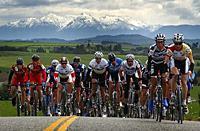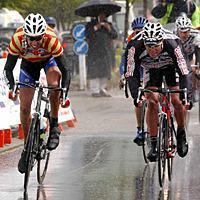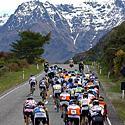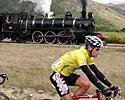
Recently on Cyclingnews.com |
Tour of Southland - 2.5
New Zealand, November 1-6, 2004
Taking a stiffy on the nose
Musings of the almost lantern rouge of the 2003 Tour of the Southland
Cyclingnews fitness forum contributor Eddie Monnier is a coach who practices what he preaches, coaching himself last year into an entry in the Tour of the Southland. He has lined up again for this year's race - which starts today - despite finishing almost last in 2003 and looks back at last year's event and forward to the 2004 edition.
The Tour of the Southland navigates through the southern most region of New Zealand's South Island. It's known as tough guy's race and has drawn an increasingly international field since it achieved UCI status three years ago (the 2004 edition will be the fourth with UCI status).
Defining attributes

|
With 10 stages in six days, the first defining factor is the mostly two-a-day stage format. The ten stages consist of a team time-trial, an individual time-trial, six moderate length road races and two long, single stage day road races. The two-a-day format provides mixed blessings. On one hand, it's easier to make the time cut off if you get dropped early in a stage. On the other hand, if you come in with the grupetto you have 30-minutes less -- about 45-minutes -- to get warm and recover before the afternoon stage begins. And getting dropped twice in one day can really hammer the ego into oblivion, to the point where you feel you might as well apply for a job as a speed bump.
The second defining attribute of this race is the tough conditions. There are always brutal crosswinds. These are unlike any you've ridden in before, unless you've done the Tour of the Southland before, in which case, "good on you." The winds can rip the peloton to shreds in under a kilometer. Day-in and day-out I was amazed by the speed with which the front echelons sped away as the strong men jumped into the wind, and others globbed on like insects flying toward a light. The echelon formed so quickly and rode away in a flash, that it reminded me of the USS Enterprise going to warp speed during the opening credits of any Star Trek episode. Missing the first three echelons meant getting stuck in a smaller group of weaker riders (weaker at least on the day), and riding your heart out as you shared the work among fewer riders and struggled to make the time cut-off. I know. It was a daily occurrence for me.

|
And if the wind weren't enough, it is rather cold and can be wet, too. In fact last year, it rained pretty much every day. If you've never spent the better part of a day riding in 40-degree rain, you don't know what it means to be chilled to the bone. On one stage, I was so cold I couldn't feel anything from my elbows down. As our five-man gruppetto approached a two kilometer rise, I desperately tried to shift to the small chain ring knowing that if I didn't make it over the climb with these guys my race would be over. While others battled for the leader and sprint jerseys, I battled to finish. I was banging my nub of a hand against the shifter but it wouldn't drop to the little chain ring. I was practically panicked. Finally, it dropped to the 39. I was so relieved it lifted my spirits and I managed again to hold on. Just barely, but I held on.
The third attribute that is unique to this race is the plethora of sprints. Whereas most stage races have three to five sprints per stage, Southland has stages with 15 or more. That's more than a points race! And they can be as closely spaced as 200 meters and may occur as early as within the first 2km of the race. That makes for some wicked fast starts and resulted in riders actually getting dropped in the neutral zone as the sprinters teams lined it out for their go-to men. Okay. We know you Kiwis and Aussies are tough. Can we please limit it to 5 sprints per stage?

|
The fourth, final and most appreciated characteristic of this race is the way the entire region has adopted the race as its very own. Race director Bruce Ross literally has people chasing him to sponsor the event. And while there are major sponsors such as title sponsor PowerNet (local electrical company), there are hundreds of smaller business and individual sponsors. No amount of money is too little. As a result, so many people feel a part of the race and it really adds to the experience. And beyond money, a great number of people contribute a wealth of their time and energy to the race. Take our managers from last year, Julie and Graeme Irvine who took a week's holiday to work tirelessly from dawn until late at night. They kept us smiling during the tough times and shared the highlights with equal pride. Early in the race, Graeme reminded us that there's only one way to eat an elephant and that's one bite at a time. Of course, we then joked about this all week. During the really tough times, we joked that we must be gumming the arse to death. But it lightened the moment and served its purpose well.
Even the school kids get into the race, because the experience is integrated into their school curriculum. They learn what each of the jerseys means, how the teams work, and about the countries the riders come from. They line the streets with their teachers to cheer on the riders, waving home made posters indicating their favorite team. It's really something to experience and even makes the back-of-the-packers feel good about themselves.
Knowing when to wage the battle... and when to withdraw
I had a high-speed crash six weeks before last year's race and was still not 100 percent at the start of the race. I could go all day at 80 percent but could not match accelerations. But at 39 years old, I didn't know when I'd have another opportunity to compete in a UCI 2.5 race, so I committed myself to giving it my all, even though I knew finishing would be a struggle. I had no appreciation for the word struggle until I experienced this race. I ground my way up Bluff Hill (10 percent with pitches at 20 percent), barely turning 45 rpm and just eking out 7 kilometers per hour as I tried to fight off cramps which almost forced me off the bike. That's struggling.

|
Day-in and day-out it was all I could do to muster the strength to continue. Julian Dean, lead-out man extraordinaire from this year's Tour de France, rode last year. On one particularly tough, cold and wet stage, I watched him get off his bike and get into the sag wagon. And while it was immediately tempting to stop myself, I couldn't. I had to go on and give it my best to finish, just to prove that I could. And I did. I finished next to last, but I finished, dammit.
Julian didn't need to prove anything to anyone. As a highly-ranked rider, his eyes were focused on bigger prizes and battles at an entirely different level. It would have been counter-productive for him to finish because he had only just resumed training. It was too much, too fast. And he's smart enough and professional enough to know that.
On a side note, Julian Dean was amazingly approachable and very humble. I know some Category 1 or 2 amateurs in the U.S. who think they're hot shit (but couldn't hold Julian's wheel if their lives depended on it) that could learn a valuable lesson from the humility of a pro like Julian.
The peculiarity of language

|
During our flight over from the U.S. we had to connect from Auckland (North Island) to Christ Church (South Island). The flight was taking considerably longer than expected. The pilot addressed the passengers, apologizing for the flight taking so long and explaining that we were "taking a stiffy on the nose" (i.e,. flying into a stiff headwind). We Amercians cracked up because stiffy has a very definite and very different meaning in American slang. And not one of us was interested in taking one on the nose (or anywhere else, for that matter). We were still laughing about it when we flew from Christ Church to Invercargill, the southern most town on the South Island. Instead of laughing, we should have seen the omen that we were about to experience winds like we'd never seen.
After grinding up Bluff Hill to finish the afternoon stage of Day 1, we huddled in the car, shivering from the cold rain and pain of our ordeal. Julie, our manager, asked, "Would you like a hottie?" to which our only reply was, "Gee, we don't think we're up to it right now." Turns our a hottie is a hot water bottle and was exactly what we needed.
Another peculiarity of the language is the use of the word "wee." It's just a wee bit further. It's only a wee little hill. Yes, a wee bit more venison please. It wouldn't be so ironic if it weren't for the fact that the blokes here are so tough and using wee is so, well, anti-tough. In fact, I've become quite convinced that the reason they're so tough here is because they have to overcompensate for the fact that they say wee just a wee bit too much.
Age ain't no excuse
Although at 39 years old, I was certainly well over the average age of the competitors, I wasn't the oldest. John Alabaster, aged 57, rocked the individual TT and positively schooled the field as he mashed a massive toothed chainring to storm to victory. At 57. Amazing. Good on ya, John.
Never say die... and never taunt a competitor

|
The powerful Zookeeper's Cafe team held the GC lead most of the week. While I did not hear any of the remarks directly, I did hear second and third hand that there had been some taunting going on by Zookeeper's. And after they defended the lead on Stage 8, the final long day of the Tour, there was a wee bit of celebrating going on that night. This included the infamous and unsanctioned Naked Criterium. The next morning during Stage 9 proved to be quite momentous. Scott Guyton of the Southland Times team (the stacked-with-talent team for the 2004 Tour) had one or two teammates up the road in a break. As the race approached the only rise of the day -- and one you'd never predict to swing the tide of the race -- Guyton put in a furious attack to bridge across to the break, and then he and his teammates went full throttle. Zookeepers tried to limit the damage to no avail. By stage end, Guyton had taken the leader's jersey with brilliant tactical riding and a never-say-die attitude. And he demonstrated the best talking in bike racing is done with the legs, not the mouth.
Back among and with friends
It's been a joy to come back and see the faces from last year that made the experience so amazing. Last year's experience was such a growth opportunity for me personally, that I promised to come back with a mostly younger team as I think the future of our sport hinges upon providing the promising stars of tomorrow a chance to experience international competition and ride to their full potential. Joining me this year on the "Share the Road" team are:
Long-time friend, teammate, and big engine Curtis Gunn, who has had an phenomenal year (fourth on Stage 2 of the Milk RAS, fourth at the US Elite Criterium Championships, and numerous titles and medals at the US Elite, US Masters and World Masters track championships). Some smart US Continental team needs to pick this motor up.
Former teammate Jeremiah Wiscovitch (U23) who is the rare rider that can climb and sprint and has an incredibly bright future ahead of him. On only three week's notice, this promising youngster competed in the San Francisco Grand Prix with his new pro team Seasilver. He made it with the peloton until 15 miles to go. What a feat!
U23 rider Sheldon Denny, who is riding with us from Jonathan Vaughters' amazing TIAA-CREF U23 team. Sheldon placed top 10 at US Espoirs Road Nats and is about to enjoy his first time competing outside North America but hopes to race some in Europe during 2005 as his team turns professional and remains focused on developing younger pros.
And finally, Sheldon's teammate Blake Caldwell (U23), another bright star on the horizon. Blake was second at the US Espoirs Road Nats, third at the US Espoirs Time Trial Championship, and scored several top-10 finishes while competing with the US U23 National Team in Europe.
These guys are the future of our sport and it will be a pleasure riding with them this week, watching them wage their own battles, and growing from the experience in their own way.
If you have a chance to visit the South Land, by all means do so, Bring a brellie and a warm coat, but soak up the beauty of the landscape and the warmth of the people.
